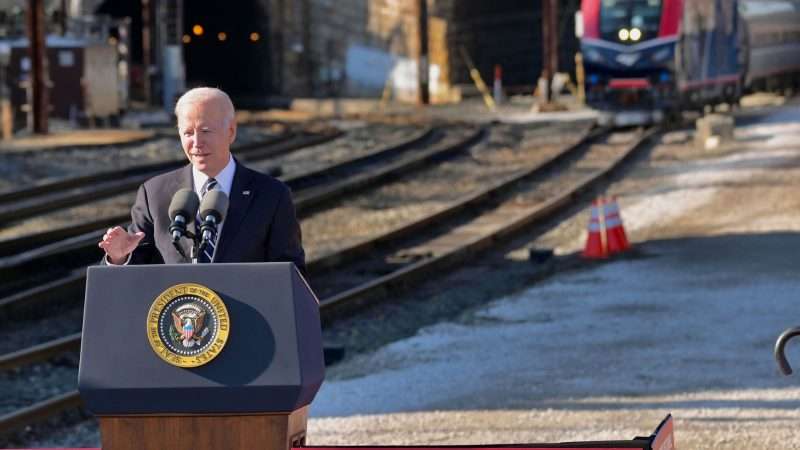
With President Joe Biden's poll numbers continuing to sag and most Americans still dour about the state of the economy, the White House is understandably trying to change both narratives by pointing to the supposedly transformational benefits of Biden's 2021 infrastructure spending package.
There's just one little problem with that plan: finding actual evidence.
Biden is frustrated about how long it is taking to turn that $1 trillion into new construction sites that would serve as convenient backdrops for reelection campaign press conferences, according to CNN. "There's immense frustration" in the fact that it could be years before some communities see real benefits from the tranche of spending that Biden and Congress authorized two years ago, one unnamed White House official tells CNN.
"He wants this stuff now," says another.
Impatient children have only another few days to wait for Christmas, but Biden will likely be waiting quite a bit longer to see any significant benefits from the infrastructure bill. Too long, perhaps, given that the clock is ticking rapidly toward the 2024 presidential election.
Some of the reasons are beyond the president's control, of course. The government is simply not very efficient at doing much of anything, and major infrastructure projects take time to plan, organize, and execute. You can't actually fix anything by simply dumping money on it, no matter how many times that approach is tried.
However, Biden does bear significant culpability for at least some of the delays that are now frustrating his White House and campaign teams. From the tightening of "Buy American" rules for federal procurement to mandates that limit the ability of nonunion construction shops to bid on these projects, the infrastructure bill Biden signed in November 2021 is loaded with provisions that were always going to slow its implementation and limit its effectiveness.
The outcome was predictable from the start. "Making waivers for Buy America provisions harder to obtain reveals the contradictory aims of Biden's infrastructure policy," Reason's Christian Britschgi wrote in April 2022. "The president wants to make 'historic' investments in infrastructure, but he's also deeply committed to regulations that ensure those investments will buy as little infrastructure as possible."
Rules requiring contractors to use American-made stuff in federally funded projects have been on the books for decades. That's one of the reasons why American mass transit projects are much more expensive than similar projects built in other parts of the world. The infrastructure bill doubled down on those problems by expanding those requirements to cover even basic materials like copper wiring, drywall, and lumber.
"The quick implementation of Buy America requirements for such a broad range of materials will cause delays in project delivery while states, contractors, manufacturers, and suppliers continue working to determine how best to track and verify these materials," Washington state Secretary of Transportation Roger Millar warned federal officials in a letter last year.
The Buy American rules are only part of the problem, however. Biden's stubborn refusal to lift tariffs imposed by former President Donald Trump means that steel (something you need for a lot of infrastructure projects) prices remain artificially high.
The infrastructure law also created delays by adding more paperwork and a confusing patchwork of new federal oversight for projects that sought funding.
"Ordinarily, Washington lets states decide how best to spend transportation money," The Wall Street Journal reported in November 2021. But the infrastructure bill gives the Biden administration a greater role in deciding which projects to fund. Those additional steps slowed everything down: "It will probably take at least a year for the Transportation Department to write the rules around the new grant programs, solicit and evaluate applications and send money to the winners," Jim Tymon, executive director of the American Association of State Highway and Transportation Officials, told the Journal for that piece.
Finally, it's worth keeping in mind something the infrastructure package didn't include: permitting reform to streamline environmental reviews that routinely hamstring federal construction projects.
For example, it's beyond absurd that it took 15 years for the federal government to approve the construction of a new electricity supply line through a mostly uninhabited area between Wyoming and Las Vegas. And those delays have serious consequences: One Princeton study found that 80 percent of the potential emissions reductions from green energy projects funded by the Inflation Reduction Act would be lost without an expansion of transmission lines.
Biden could have pushed for an infrastructure bill that focused on actually building infrastructure—and that aimed to do so in a speedy, cost-effective way. Instead, the final product was a sop to labor unions and other political allies. At nearly every turn, the infrastructure package opted for policies that limited supplies, hiked prices, added paperwork, and grew government.
Two years later, the White House is only now recognizing the tradeoffs that come with those choices.
The post How Biden Hobbled His Own Infrastructure Push appeared first on Reason.com.







